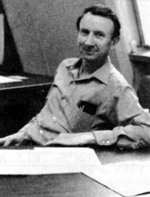"NAL in Transistion" - Boyce McDaniel

Boyce McDaniel
We're in a transition phase," Dr. Boyce McDaniel observed, "between construction and operation. Our most important job is to make our machine run at its design specifications. Each day we know more than we did yesterday and we know with a little more certainty what's going to happen tomorrow."
Dr. McDaniel's cautious optimism characterized the attitude of the NAL Accelerator Section in spring, 1972. Under Dr. McDaniel's leadership, this group faced such challenging tasks as achieving regular, effortless acceleration, raising beam intensity by a factor of 1,000, and then extracting a high quality beam to the experimental areas. "The job we had is much less glamorous than reaching 200 BeV for the first time, but it is certainly just as important," he said.
Dr. McDaniel and his wife, Jane, came to NAL on leave from Cornell University where he served as Head of the Laboratory of Nuclear Studies. He had been associated with Cornell since 1938 except for a time at Case Western Reserve University (1938-1940), a year at the Radiation Laboratory of MIT, and three years at Los Alamos (1943-45). He was appointed assistant professor of physics at Cornell in 1945, professor in 1956.
Dr. McDaniel brought to NAL a working knowledge of synchrotron development, gained from 25 years' experience in this field at Cornell where a progression of electron synchrotrons was built, beginning with a 300 MeV machine, and including the first machine to apply the strong focusing principle. Cornell's 10 BeV electron synchrotron, completed in 1967, is the largest in the world.
Dr. McDaniel had done experimental work, as well as development, but he said, "I'm here at NAL primarily to help get this complex system running."
This phase of NAL development saw the permanent operating structure emerge, he felt. "I have found the people here to be remarkably cooperative and responsive. That will certainly make it easier to get the job done."


